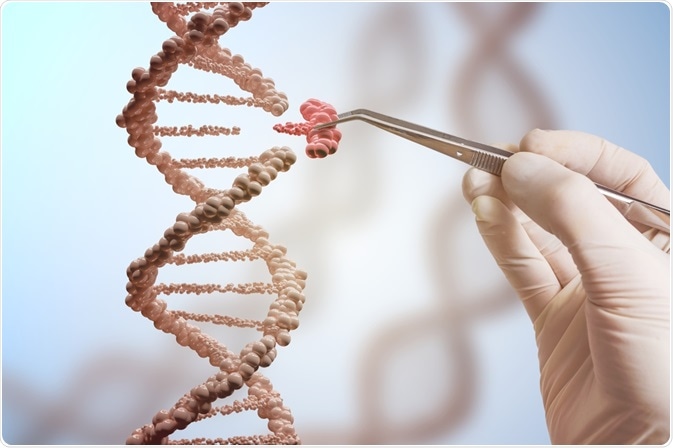Gene therapy is a therapeutic strategy used to treat disease by correcting defective genes or modifying how genes are expressed.

Image Credit: vchal / Shutterstock.com
Introduction
The techniques used in gene therapy involve the administration of a specific DNA or RNA sequence. Researchers hope that in the future, gene therapy will enable patients to be treated by inserting genes into their cells, rather than requiring them to take drugs or undergo surgery.
Gene therapy offers a promising new approach to treating a wide range of diseases including various forms of cancer, inherited diseases, and certain viral infections. However, further studies are still required to ensure the safety and effectiveness of these techniques. Currently, gene therapy is only used to treat diseases where other therapies are already known to be ineffective.
There are two basic types of gene therapy that include germline therapy and somatic gene therapy.
Germline therapy
Germline therapy involves the modification of the genes inside germ or gamete cells, which include sperm or ova. Germline therapy would therefore be administered during reproduction, where the modified gamete cells fuse to form a zygote. Once fused together, the zygote divides and passes on the modified gene to all other cells of the body during the development of offspring. In this way, germline therapy alters the genome of future generations to come.
Although theoretically, germline therapy could counteract hereditary diseases, jurisdictions in various countries such as Switzerland, Australia, and Germany prohibit the use of germline therapy due to fears on the unknown risks of this therapy and whether it causes any long-term effects in future generations. Germline therapy is also extremely expensive, which further limits its practical use.
Somatic gene therapy
Unlike germline therapy, somatic gene therapy involves the insertion of therapeutic DNA into body cells, rather than germ cells or gametes. This means that any effects of the therapy are confined to the individual being treated and are not inherited by future offspring.
The field of somatic gene therapy is surrounded by fewer ethical issues as compared to germline gene therapy. While this may be true, this therapeutic approach remains in the early stages of development.
The first hurdle in somatic gene therapy is the successful incorporation of the new gene into the genome. In fact, integrating the modified gene into the wrong part of the DNA could induce rather than prevent disease. In addition to requiring the desired gene needs to be expressed, the gene expression of the new gene needs to be regulated in order to prevent over-expression that could also trigger disease.
Gene Therapy: Your Questions Answered
Gene therapy for cancer
One of the most challenging aspects of gene therapy is the insertion of genes into cancer cells. Therefore, experts are striving to find new and improved techniques for achieving this.
One of the main ways gene insertion is carried out is through the use of a vector, which carries a gene into a cancer cell. Since viruses are built to target and enter cells, viral vectors are often used to deliver genetic material to cancer cells in gene therapy. Scientists have found ways to alter these viruses in order to ensure that vectors only deliver genes to cancer cells rather than healthy cells. In addition to viruses, other vectors that are also being tested include inactivated bacteria.
Several different gene therapy techniques have been investigated for cancer treatment, of which include those that harness the immune response, enhance cancer treatment therapies, block the protection of cancer cells against cell death and convert inactive drugs to active drugs.
Harnessing the immune response
Some forms of gene therapy are designed to strengthen the body’s existing ability to target and kill cancer cells. The role of certain cells of the immune system is to recognize and kill these cells; therefore, the addition of certain genes into a patient’s immune cells has been hypothesized to improve their ability to find or kill certain forms of cancer.
Gene therapy to enhance cancer treatment
Some gene therapy techniques involve the insertion of genes into cancer cells in order to make the cancer cells more vulnerable to radiotherapy or chemotherapy, thereby improving the effectiveness of these treatments.
Blocking the protection of cancer cells
Gene therapy can be used to block the different survival processes used by cancer cells. One example of this includes apoptosis, which refers to the programmed cell death a cell undergoes if it contains DNA that is damaged and beyond repair. In cancer cells, apoptosis is stopped and the cells continue to divide, thus forming new cells that also contain the damaged DNA. Some gene therapy techniques are designed to prevent this inhibition of apoptosis to ensure that the cancer cells do in fact die rather than continue to survive and proliferate.
Pro-drug gene therapy
Certain gene therapy techniques involve the insertion of certain genes into cancer cells to allow for the conversion of an inactive drug called a pro-drug into the active form. The converting gene is given in the form of a tablet or capsule and the pro-drug is then administered. The pro-drug does not harm normal cells and only reaches cancer cells, where it is activated by the gene to become destructive.
References
Further Reading
Last Updated: May 16, 2023